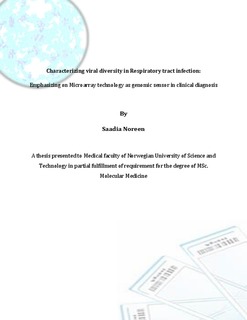Characterizing viral diversity in Respiratory tract infection: Emphasizing on Microarray technology as genomic sensor in clinical diagnosis
Master thesis
Permanent lenke
http://hdl.handle.net/11250/263659Utgivelsesdato
2013Metadata
Vis full innførselSamlinger
Sammendrag
Background: Acute respiratory tract infection is common illness of human with significant morbidity and mortality. In pediatrics, viruses are the major cause if this illness. There is an imperative need to develop a diagnostic tool to measure viral diversity for preventing contraproductive treatments. This present study focuses on evaluating viruses from clinical samples of respiratory tract infection by using advanced diagnostic method such as microarray technology.
Methods: Target was amplified using random amplification. Indirect method of hybridization was used to fluorescently label target with Cy3. A previously developed LLMDA subarray 2 (GPL13407) was demonstrated as detectichip. This chip comprise of 58,000 probes. The detectichip was designed by Agilent technologies. Samples were hybridized on this chip. The resulting fluorescent produce after hybridization was explored and digitized using gene pix pro software. Data was normalized with two methods named as 1) within array control method 2) with whole negative control array. Log 2 fold change was calculated. Significant testing was also performed. Detecti V software was used to perform these tasks.
Results: Detected viral species were arranged according to their log2 fold change. The higher log 2 fold change indicated the abundance of viral species in sample. More over graphs and figures were also drawn to indicate the detection of viral species. Significant testing indicates the presence of high level viral families according to their p-value and t testing.
Conclusion: Detectichip can successfully characterize viruses frequently found in clinical samples. By applying both normalization method it can be stated that this detectichip able to identify broad spectrum of viral family, viral species, bacteriophages, plant virus. The likely viral RTI were adenovirus, influenza virus, rhino virus. The rare virus associated with RTI was human papilloma virus and mammalian orthoreovirus. This chip confirms that in sample 1 adenoviridae family was significantly present where as in sample 2 the likely specie is Influenza .
